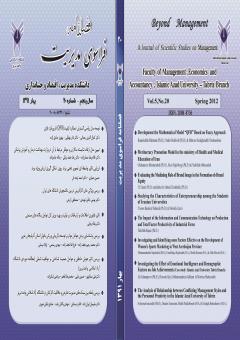Development the Mathematical Model “QFD” Based on Fuzzy Approach
Subject Areas : Business ManagementKamaledin Rahmani 1 , Nader Bahloli 2 , Behrooz Sadeg zadeh 3
1 - Faculty Member (Assistant Professor) Department of Management, Tabriz Branch, Islamic Azad University, Tabriz, Iran
2 - Associate Professor, Department of Management, Bonab Branch, Islamic Azad University, Bonab,Iran
3 - Master of Business Administration (Production Orientation), Bonab Branch, Islamic Azad University, Bonab, Iran
Keywords: Quality function development (QFD), Network Analysis Process (ANP), Idealized programming(ZOGP), Axel,
Abstract :
Nowadays, the systematic transfer of customers, demands and comments and converting them to practical measures in line with the modification or correction of the product have become of immense importance for the companies in order to achieve success and competitive primacy . In this regard, companies have proceeded to seek higher levels of quality for their products and services as well as to improve them continually in order to keep up with the rapid pace of progress and change all over the world. The present survey attempts to present a mathematical model for quality function development (QFD) based on fuzzy approach which can consider customers demands and comments. For this purpose, first the demand and desired technical properties were identified by using QFD method. Then, by ANP method, we specified the demands and weighed technical properties as well as the rate of thecorrelation of demand and technical properties. Finally, the idealistic programming model was presented which includes different level of importance of technical needs through the use Fuzzy ANP method, such as limitation of financial resource, rate of feasibility, and degree of competitiveness, which should be considered in the designing phase. In conclusion, in order to test the presented model, we have shown the result of applying the model in a case study related to the production line of “Axel” in “X” industrial manufacturing company
Azar, A., & Nahavandi, B. (2008). Designing and Improving Expansion of Quality Function Using Fuzzy Network Analysis and Arlan Planning Process. 12(4), 37-68, (In Persian).
Han, S.B. & Chen, S.K. & Ebrahimpour, M. & Sodhi, M.S.,(2001), A conceptual QFD planning model, International Journal of Quality and Reliability Management, 18 (8), 796–812
Zadeh, L. A. (1965), Fuzzy Sets, Information & Control, 8, 338-353.
Temponi.C, Yen.J & Tiao.W.A ;(1999), House of Quality: A Fuzzy Logic-Based Requirements Analysis, European Journal of Operation Research, 117, 340-354.
Karsak EE, Sozer S, Alptekin SE ;( 2002), Product planning in quality function deployment usinga combined analytic network process and goal programming approach. Computers Industrial Engineering; 44:171–190.
Najmi M., Ebrahimi, M., & Kianfar, F. (2006). Prioritizing Technical and Engineering Characteristics in the QFD Model Using the TOPSIS Method in Fuzzy Mode. Journal of Sharif University of Science and Technology, 35, 3-9. , (In Persian).
Saaty, T.L; (1980), The Analytic Hierarchy Process. McGraw-Hill, New York.
Shim, J.P (1989), Bibliographical research on the analytic hierarchy process. Socio-Economic Planning Sciences 23, 161–167.
Saaty, T.L; (1996), Decision Making with Dependence and Feedback: The Analytic Network Process. RWS Publications, Pittsburgh.
Kaufmann. A, Gupta.M.M; (1991), Introduction to fuzzy arithmetic theory and applications. New York: Van No strand Reinhold.
Buckley JJ; (1985), Fuzzy hierarchical analysis. Fuzzy Sets System; 17:233–247
Zhu K-J, Jing Y, Chang D-Y ; (1999), A discussion on extent analysis method and applications of fuzzy AHP. European Journal of Operation Research; 116(2), 450-456.
_||_
Azar, A., & Nahavandi, B. (2008). Designing and Improving Expansion of Quality Function Using Fuzzy Network Analysis and Arlan Planning Process. 12(4), 37-68, (In Persian).
Han, S.B. & Chen, S.K. & Ebrahimpour, M. & Sodhi, M.S.,(2001), A conceptual QFD planning model, International Journal of Quality and Reliability Management, 18 (8), 796–812
Zadeh, L. A. (1965), Fuzzy Sets, Information & Control, 8, 338-353.
Temponi.C, Yen.J & Tiao.W.A ;(1999), House of Quality: A Fuzzy Logic-Based Requirements Analysis, European Journal of Operation Research, 117, 340-354.
Karsak EE, Sozer S, Alptekin SE ;( 2002), Product planning in quality function deployment usinga combined analytic network process and goal programming approach. Computers Industrial Engineering; 44:171–190.
Najmi M., Ebrahimi, M., & Kianfar, F. (2006). Prioritizing Technical and Engineering Characteristics in the QFD Model Using the TOPSIS Method in Fuzzy Mode. Journal of Sharif University of Science and Technology, 35, 3-9. , (In Persian).
Saaty, T.L; (1980), The Analytic Hierarchy Process. McGraw-Hill, New York.
Shim, J.P (1989), Bibliographical research on the analytic hierarchy process. Socio-Economic Planning Sciences 23, 161–167.
Saaty, T.L; (1996), Decision Making with Dependence and Feedback: The Analytic Network Process. RWS Publications, Pittsburgh.
Kaufmann. A, Gupta.M.M; (1991), Introduction to fuzzy arithmetic theory and applications. New York: Van No strand Reinhold.
Buckley JJ; (1985), Fuzzy hierarchical analysis. Fuzzy Sets System; 17:233–247
Zhu K-J, Jing Y, Chang D-Y ; (1999), A discussion on extent analysis method and applications of fuzzy AHP. European Journal of Operation Research; 116(2), 450-456.


